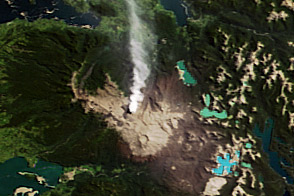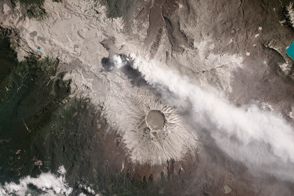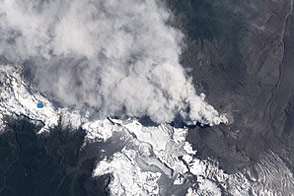

Though less dramatic than the initial eruption in June, Chile’s Puyehue-Cordón Volcano Complex continued releasing ash and steam in early July 2011. Shifting winds moved the plume in different directions, sometimes over the Pacific and sometimes over South America, where ash interfered with air traffic.
On July 8, 2011, the Moderate Resolution Imaging Spectroradiometer (MODIS) on NASA’s Terra satellite observed the plume blowing toward the east-southeast (top). On July 2, 2011, MODIS on NASA’s Aqua satellite observed the plume blowing toward the northwest (bottom).
Volcanic plumes can contain a combination of ash, steam, and gases invisible to the human eye. The light color of the plumes in these images suggests that the visible components in the plumes are a mixture of water vapor and some ash. Ash already deposited by this eruption coats the landscape east of Puyehue-Cordón in beige.
Unlike the soft ash from wildfires, volcanic ash consists of jagged particles of rock and glass. Abrasive, slightly corrosive, and capable of conducting electricity when wet, volcanic ash can complicate breathing, coat vegetation and leave it inedible, and even destroy machinery. Planes flying into volcanic ash clouds can experience rapid engine failure.
Volcanic ash released by Puyehue-Cordón continued to cause difficulty in South America in early July. Agence France-Presse reported that the plume disrupted air travel in parts of Argentina, Brazil, and Uruguay. Meanwhile, provinces in southwestern Argentina were in a state of emergency because of widespread damage from the ash layer.
SERNOGEOMIN, Chile’s geology and mineral agency, reported that although ash and steam emissions continued, activity had decreased significantly and lava flows had apparently stopped. The agency did not rule out a future explosive eruption, although it reported such an event would be unlikely to equal the magnitude of the June event.
NASA images courtesy Jeff Schmaltz, MODIS Rapid Response Team, Goddard Space Flight Center. Caption by Michon Scott.
Image of the Day Atmosphere Land Volcanoes
These natural-color images show the plume from Puyehue-Cordón Volcano Complex blowing in different directions.
Image of the Day for July 12, 2011
Chile's Puyehue-Cordón Caulle Volcano erupted on June 4, 2011, and continued until April 2012. The effects of the eruption continue to be felt in the region.



